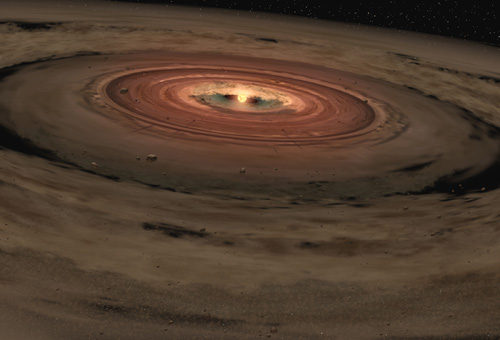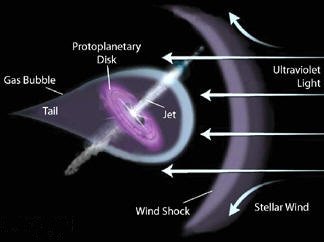protoplanetary disk

Artist's impression of a protoplanetary disk around the brown dwarf OTS44.

Diagram of a protoplanetary disk.
A protoplanetary disk is a circumstellar disk of matter, including gas and dust, from which planets may eventually form or be in the process of forming. The existence of such disks was long suspected (see planetary systems, formation) but was confirmed by direct imaging in 1994 when C. Robert O'Dell and colleagues of Rice University used the Hubble Space Telescope (HST) to examine newborn stars in the Orion Nebula. About half of those were found to be surrounded by disks of gas and dust. Prior to this, in the 1980s, dust disks, believed to be regenerated disks, had been discovered around a number of more mature stars using the Infrared Astronomy Satellite. Additionally, infrared studies of nearby star-forming regions by Stephen and Karen Strom's group at the University of Massachusetts, Amherst, had revealed that at least 50% of all 1-million-yr-old stars have excess infrared emission, suggesting that they are surrounded by warm dust. In 1994, John Stauffer and associates of the Harvard-Smithsonian Center for Astrophysics reported that 70 to 80% of infant stars at the center of the Orion Nebula showed signs of having disks. This high fraction has since been confirmed by more sensitive observations by the Infrared Space Observatory.
In 1999, some of the clearest views yet seen of protoplanetary disks came from observations by the HST. A group at the California Institute of Technology's Image Processing and Analysis Center, in Pasadena, used NICMOS to peer through obscuring dust clouds surrounding six extremely young stars in a stellar nursery in Taurus, 450 light-years away. Evidence for dusty disks, 8 to 16 times the diameter of Neptune's orbit, was found in all six in the form of dark bands, believed to be dust lanes, crossing the bright areas around each star. Dark clumps and bright streamers above and below the dust lanes, apparent in the NICMOS images, suggest that raw material is still falling into the disks and driving outflowing jets of gas from the young stars. At about the same time, another group using Hubble took very sharp visible-light pictures of disks in the same region. John Krist of the Space Telescope Science Institute in Baltimore found that the young star Haro 6-5B is actually a small nebula crossed by a dust lane about 10 times the size of Neptune's orbit. Also in 1999, Karl Stapelfeldt of the Jet Propulsion Laboratory used Hubble's Wide Field and Planetary Camera 2 to spot the first example of an edge-on disk in a young binary star system. The disk is centered on the fainter component and has a diameter of only 31 times the diameter of Neptune's orbit. This offers further evidence that, in spite of theoretical predictions that the gravitational forces in binaries ought to tear apart fragile protoplanetary disks, planetary formation may well be able to occur in two-star systems.
Conventional theory suggests that about 10 million years are required for a planetary system to form completely from a protoplanetary disk, so that, on this basis, the disks mentioned above might not yet be old enough to contain planets. They should, however, be at the stage where dust grains are accreting to give larger particles. This was confirmed in 1998 by observations carried out with the HST by Larry Esposito and colleagues at the University of Colorado which showed that the disks around three stars in the Orion Nebula contain dust at least 10 microns across, or nearly 100 times larger than dust grains in interstellar space.
Some young protoplanetary disks are thought to have a mass of 0.01 to 0.1 solar masses, or more than 10 times that needed to make a planetary system like our own. Much of this material will eventually be blown away by the strong stellar wind from the central star. Dust accounts for about 1% of the disk's initial mass, the rest being made up of gas, mainly hydrogen and helium. Young disks imaged by the HST, in Orion and Taurus, are seen at many different angles, from edge-on to nearly face-one, and are typically a few hundred astronomical units in diameter. Two of the most spectacular edge-on disks surround HH 30 and the "Butterfly Star," both of which are narrow in their central parts but gently flare at distances of about 100 astronomical units. Such flaring was predicted as a result of heating by the host star by Harvard-Smithsonian astronomers Lee Hartman and Scott Kenyon in the late 1980s.
As accretion continues within a protoplanetary disk, sizable objects known as planetesimals form which, after several million years, give rise to small, rocky planets close to the host star. Further out, where it is cold enough for ice to form in the disk, more solid material is available for world-building. Gas giants, like Jupiter and Saturn, may start with cores of rock and ice of about 10 Earth-masses and then sweep up large quantities of light gases to form thick atmospheres. This should result in the creation of a central cavity within the circumstellar disk, similar in size to the solar system, and a drastic depletion of the disk's gas content. Recent observations, for example of the 10-million-yr-old star HR 4796A, provide evidence for this view.
Studies of more mature stars, around which dust rings have been detected, including Beta Pictoris, Vega, and Epsilon Eridani, suggest that the circumstellar material is in the form of regenerated disks. There is also indirect evidence of planets in these systems.


